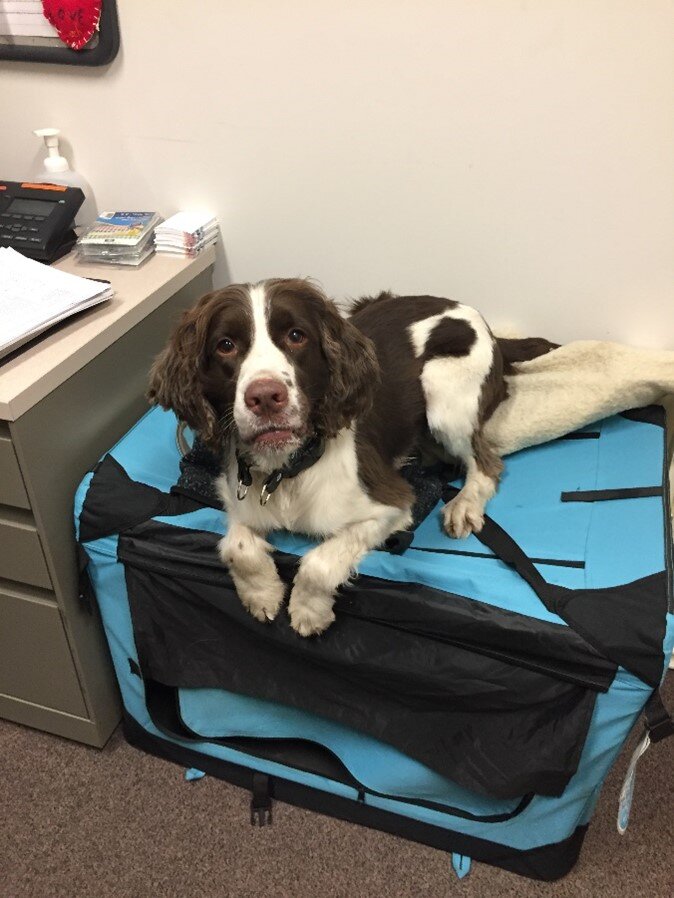A Versatile Breed
FIELD SPANIELS IN OTHER
WORKING ENVIRONMENTS
Medical Detection Dogs
Angus
C. difficile Canine Scent Detection at Vancouver Coastal Health
Clostridium difficile (C. difficile) is the most common cause of acute
diarrhea in hospitals and long-term care facilities in North America.
Over 60% of C. difficile cases are acquired within healthcare
facilities. Reducing environmental contamination plays a key role
in preventing the spread of infection to immunocompromised
patients and healthcare workers.
Canine scent detection for health care environments
C. difficile is extremely resilient, and, depending on conditions, can
persist in the open environment for several months – spores are
resistant to common routine cleaning agents and hand sanitizers,
and have been shown to travel by physical means, making them
very difficult to eliminate. Special chemical disinfectants &
protocols are required to eradicate C. difficile, but the challenge lies
in knowing where the contamination exists in order to take
necessary steps to keep our healthcare facilities safe.
Identifying environmental contamination with 97% accuracy
Newest Edition to Vancouver General Hospital - FINN
(from Rocky’s Kennel, Utah)
BOMB - Detection Dogs
Dodger
Buster
Bomb Detection Dog
The Springer Spaniel is used as a sniffer dog. Notable search dogs have included Buster, a Dickin Medal recipient, Royal Army Veterinary Corps arms and explosives search dog serving with the Duke of Wellington's Regiment in Iraq, for finding an extremist group's hidden arsenal of weapons and explosives.
Another example is Jake, aka Hubble Keck People's Dispensary for Sick Animals Gold Medal and Blue Cross Animal Hospital Medal recipient, a London Metropolitan Police explosives search dog. He was deployed at Tavistock Square, Russell Square and King's Cross following the 7 July 2005 London Bombings.
The Springer is not limited to detecting explosives. Other varied uses for the Springer can include sniffing out bumblebee nests, illegal immigrants, and blood. Springers are used for drug detection in the United Kingdom, Sweden, Finland, Isle of Man, Ireland, Canada CBSA and Qatar.
The Springer Spaniel is also used as a search and rescue dog by mountain rescue and Lowland Rescue teams, where their willingness to work and cover rough terrain makes them an excellent choice.
When we hear about a military dog that’s saved thousands of lives, we suspect that most of us would guess the dog to be a Malinois, Dutch Shepherd or German Shepherd. “Buster,” a Springer Spaniel, shattered that notion. Over the course of his career, Buster is believed to have saved over a thousand lives by sniffing out improvised explosive devices (IEDs), weapons and other ammunition, patrolling British bases, searching vehicles at check points, and foiling suicide bombers in Afghanistan after discovering their explosive vests, work for which the keen nose of his breed was well suited. Buster earned a slew of medals for his service over the course of five tours of duty to Afghanistan, Bosnia and Iraq, and at long last, he was retired from the RAF (Royal Air Force) in 2011. Upon retirement, Buster was made the official RAF Police mascot.
Buster passed away at the age of thirteen last year (July 16, 2015) at the home of his handler, Flight Sergeant Will Barrow. His time on earth, and the service he provided..
Liam Tasker and Theo - Bomb Detection Team
Even though animals have been fighting in battle alongside humans for thousands of years, only since the dogs like Theo have proved to be immensely valuable in detecting explosives. Their keen senses of smell, approximately forty times stronger than ours, can pick up the scent of dangerous chemicals far more rapidly and accurately than any human could. Indeed, with their three hundred million smell receptors, compared to our mere five million, the canine nose can pick up smells that we do not even know exist.
Theo, who was born in May 2009, began his term of service for the British Army in September 2010, when he was posted to Afghanistan. That would be his first and, sadly, only tour of duty. He was just two months shy of his second birthday when he died.
Liam Tasker, who was 26 years old when he was killed, had joined the Royal Army Veterinary Corps in 2007, and was an experienced dog trainer and handler. He and Theo, the third dog Tasker had worked with, developed an extremely close bond. From that point on, they were inseparable – and the strength of the bond between them could not even be severed by death.
DRUG DETECTION - SECURITY
Danny
Trained Drug Detection Dog Springer Spaniel for Sale. This 30-month young Springer Spaniel is trained as a passive alert drug detection dog and is ready for certification by the AWDA. He has been trained to locate. Narcotic detection dogs are trained to detect the presence of controlled substances such as heroin, marijuana, cocaine, crack cocaine, and methamphetamines.
These dogs are trained to find the substances in various locations such as vehicles, luggage, mail packages, cargo, residences and businesses. This drug detection dog is a passive alert dog, meaning that he will sit to alert the handler that the scent cone is present. The drug detection dog will then follow the scent cone of the odor to the source and alert on that source. Springer spaniels are often used as detection dogs. Their high drive and commitment as hunting dogs to finding the source is important in detection dog work.





